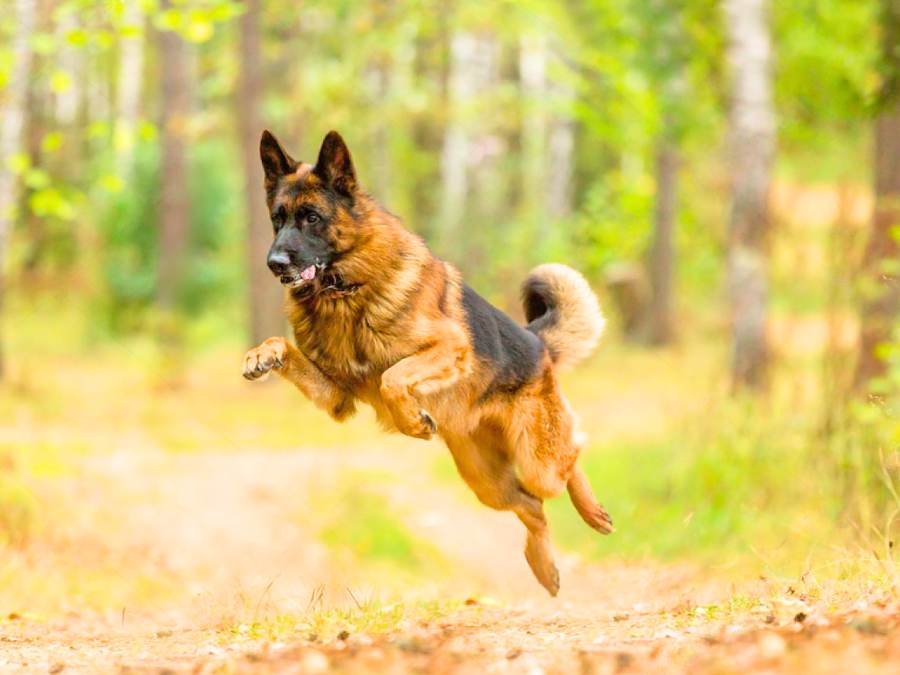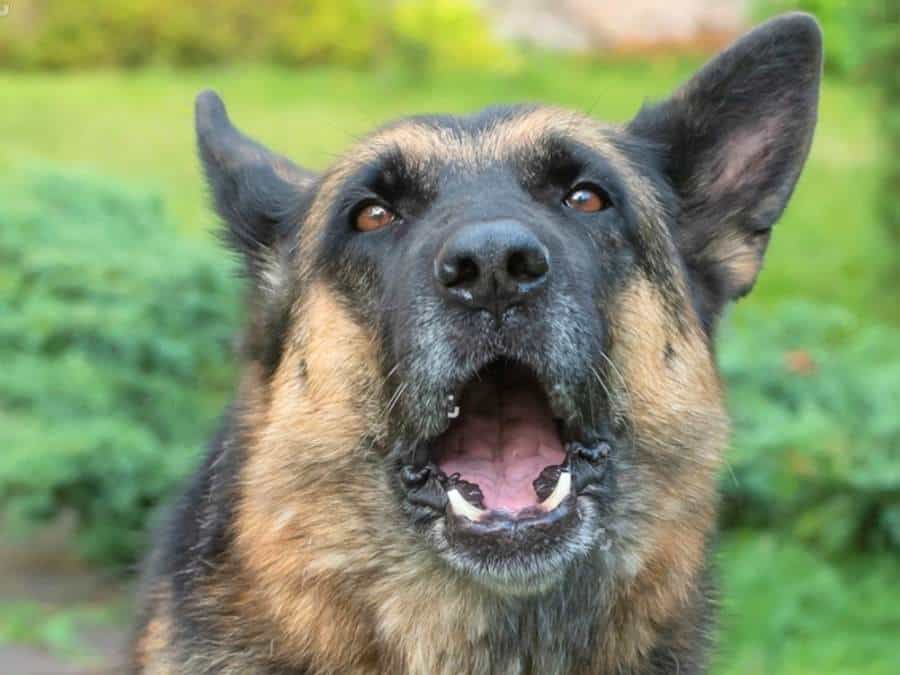Understanding a German Shepherd’s energy level is crucial for their well-being and to ensure your lifestyle is compatible with their needs. These dogs are known for their high energy and require regular, vigorous exercise to maintain their mental and physical health.
This article will explore the factors responsible for a German Shepherd’s energy level, signs of high energy, and how to meet their exercise needs effectively.
Whether you’re a current German Shepherd owner or considering adding one to your family, this guide will help you understand and manage the dynamic energy levels of this remarkable breed.
Factors Influencing German Shepherd Energy Levels
The energy levels of German Shepherds can vary significantly from one dog to another and are influenced by a variety of factors.
1. Genetics
German Shepherd. Dog come from a lineage designed for work, particularly herding and guarding, which requires not only physical stamina but also mental acuity.
Over generations, these traits have been honed and passed down, resulting in a breed with a natural predisposition towards high energy and activity.
These dogs have a genetic makeup that predisposes them to be active, alert, and ready to engage in tasks that require significant physical and mental effort.
RELATED: German Shepherd Herding Behavior
2. Age
Puppies and young adults typically have more energy and require more physical activity and mental stimulation. As dogs age, their energy levels generally decrease, and they may require less intense exercise routines.

3. Health and Physical Condition
German Shepherds that are healthy and well-conditioned can sustain higher levels of activity.
In contrast, those with health issues, such as hip dysplasia or arthritis, which are not uncommon in the breed, may have lower energy levels and require modified exercise plans to accommodate their physical limitations.
4. Diet and Nutrition
What a German Shepherd eats plays a crucial role in their energy levels.
A balanced diet that meets a German Shepherd’s nutritional needs based on their age, size, and activity level can support their energy requirements.
Overfeeding and underfeeding can both negatively impact energy levels, leading to obesity or malnourishment, respectively.
5. Mental Stimulation
The need for mental stimulation can influence a German Shepherd’s perceived energy levels.
Dogs that do not receive enough mental engagement through training, puzzle toys, or other stimulating activities may exhibit signs of high energy or restlessness.
Providing adequate mental challenges can help manage their energy levels effectively.
6. Living Environment
Dogs with access to large, open spaces where they can run and play are likely to have different energy expenditure than those confined to smaller, restricted areas.
Additionally, dogs that live in more stimulating environments, with plenty of opportunities for interaction and exploration, may have different needs than those in more sedentary settings.
7. Socialization and Training
Well-socialized and trained German Shepherds, who have learned to channel their energy into appropriate behaviors, may appear calmer and more controlled.
In contrast, dogs lacking socialization or training may exhibit higher energy levels through undesirable behaviors.
German Shepherd Energy Level by Age
Understanding the energy levels of a German Shepherd at different life stages is crucial for providing appropriate care, exercise, and mental stimulation.
From the boundless energy of puppies to the more measured pace of seniors, each phase of life comes with unique needs and considerations.
Puppyhood (0-12 Months)
German Shepherd puppies are bundles of energy, curiosity, and playfulness. This life stage is characterized by rapid growth and development, both physically and mentally.
Puppies will often have bursts of high energy followed by periods of rest. It’s important to manage their energy through short, frequent play sessions and walks that don’t overtax their developing joints.
Training sessions can also begin at this stage, offering mental stimulation and establishing the foundations of good behavior.
Adolescence (1-3 Years)
As German Shepherds enter adolescence, their energy levels can remain high but become more consistent.

They have a great capacity for exercise and can handle longer walks, hikes, and more intensive training sessions. This is an ideal time to engage in more structured activities such as agility training, advanced obedience classes, or even canine sports.
Despite their physical capabilities, it’s essential to balance activity with discipline and training to manage their energy positively and prevent the development of unwanted behaviors.
Adulthood (3-7 Years)
Upon reaching adulthood, a German Shepherd’s energy level may start to plateau. While still energetic, adults have a more settled temperament and can better handle variations in their exercise routine.
Consistent, vigorous exercise remains important, and activities should continue to challenge them physically and mentally.
This stage is an opportunity to deepen the bond through shared activities, reinforcing training and exploring new challenges together.
Senior Years (8+ Years)
As German Shepherds enter their senior years, you’ll notice a gradual decrease in energy levels. Exercise is still important for maintaining health and mobility, but activities should be adjusted to match their aging bodies.
Shorter, more frequent walks, gentle play, and activities that maintain mental agility without excessive physical strain are ideal.
It’s also a time to closely monitor their health, adjusting diet and exercise to accommodate any age-related conditions.
By understanding and adapting to the changing energy levels of a German Shepherd throughout their life, owners can ensure their dogs remain happy, healthy, and well-adjusted members of the family.
RELATED:
Recognizing the Signs of High Energy in German Shepherds
Physical Signs
German Shepherds with high energy levels often display unmistakable physical signs.
Constant movement is a key indicator; these dogs may pace around the house, have difficulty settling down, or seem always ready for action.
Jumping, restlessness, and an eagerness to engage in physical activity whenever the opportunity arises are also common traits.
Observing these behaviors can help you gauge whether your German Shepherd is getting enough exercise or if their energy levels are not being adequately managed.

Behavioral Signs
Behavioral signs of high energy in German Shepherds can include excessive chewing, barking, or digging.
These behaviors are not only manifestations of their physical energy but also their mental stimulation needs.
An under-stimulated German Shepherd may resort to destructive behaviors as a way to release pent-up energy.
Recognizing and addressing these signs through adequate exercise and mental stimulation can prevent behavioral issues and promote a healthy lifestyle.
RELATED: How Much Exercise Does a German Shepherd Need?
How to Meet the Needs of a High-Energy German Shepherd
The Role of Physical Exercise
Physical exercise plays a pivotal role in managing a German Shepherd’s energy levels. Daily walks, running, agility training, and other physical activities help burn off excess energy and keep your dog physically and mentally healthy.
These activities not only cater to their instinctual need for movement but also help prevent obesity and related health issues, ensuring your German Shepherd maintains a healthy weight and muscle tone.
Mental Stimulation Activities
Mental stimulation is equally important for high-energy breeds like German Shepherds.
Puzzle toys, training sessions, and scent work can provide mental challenges that tire them out in a different but equally effective way as physical exercise.
These activities can help improve their problem-solving skills, reduce boredom, and prevent destructive behaviors by keeping their minds engaged.

The Importance of Routine and Consistency
Establishing a routine and maintaining consistency in exercise and training are crucial for German Shepherds. A consistent schedule helps manage their expectations and energy levels, ensuring they remain balanced and well-behaved.
It also reinforces training and good behavior, making exercise both a physical activity and an opportunity for learning and bonding.
RELATED: Why Is My German Shepherd So Hyper? 10 Tips To Calm Them
Activity Ideas for High Energy German Shepherds
German Shepherds with high energy levels require a variety of physical and mental exercises to stay healthy, happy, and well-behaved. These activities not only help in managing their energy levels but also in strengthening the bond between you and your dog.
Here are some exercise and activity ideas tailored for German Shepherds:
1. Structured Walks and Runs
Structured walks and runs are essential for high energy dogs. Incorporating varying paces, incorporating obedience training during the walk, and using different routes can keep these activities engaging for your German Shepherd.
2. Fetch and Frisbee
Fetch and Frisbee are classic games that most dogs love, and they’re particularly good for high energy breeds. These activities allow them to run freely and burn off excess energy.

Using a variety of toys or Frisbees can keep the game interesting and encourage your German Shepherd to engage more enthusiastically.
3. Hiking and Outdoor Adventures
German Shepherds thrive on adventure, making them perfect companions for hiking and exploring the great outdoors. The varied terrain and new smells and sights provide both physical and mental stimulation.
4. Tug-of-War
Tug-of-war is a great way to engage your German Shepherd’s muscles and satisfy their natural instincts.
It’s also an opportunity for teaching self-control and strengthening your bond through play. Ensure you teach your dog to release the toy on command to incorporate discipline into the game.
5. Agility Training
Agility training is a fantastic way to channel a German Shepherd’s energy into something constructive. Navigating through obstacle courses not only provides physical exercise but also requires mental focus, making it a comprehensive workout.
6. Training Sessions
Regular, structured training sessions are invaluable for mental stimulation. Teaching new tricks, commands, or even competitive obedience and protection sports can keep your German Shepherd’s mind engaged.
Training enhances their learning capabilities, reduces boredom, and promotes a well-behaved companion.
7. Scent Work and Tracking
Scent work and tracking activities tap into the German Shepherd’s natural abilities, providing a unique mental workout.
Starting with simple games like hiding treats around the house to more structured tracking exercises outdoors can be both challenging and rewarding for your dog.
RELATED: What To Do With German Shepherd While at Work?
8. Swimming
For German Shepherds that like water, swimming is an excellent low-impact exercise that’s particularly beneficial for German Shepherds.

It allows them to cool off on hot days while providing a full-body workout that’s easy on the joints.
9. Interactive Toys and Puzzle Feeders
Interactive toys and puzzle feeders are perfect for times when you need to keep your German Shepherd entertained indoors.
These toys challenge their problem-solving skills, providing mental stimulation that can tire them out just as much as physical exercise.
10. Socialization Activities
Socializing with other dogs at the park or doggy daycare can provide essential exercise and playtime. It’s also an excellent way for your German Shepherd to learn appropriate social behavior, improving their interactions with other dogs and people.
Regularly incorporating a variety of these exercises and activities into your dog’s routine will help maintain their physical health, mental sharpness, and emotional contentment, ensuring a happy and harmonious household.
If you don’t have enough time in the day to provide 1-2 hours of exercise to your GSD, then you should check out my article How to Tire Out a German Shepherd (No Walking/Jogging).
Consequences of Not Meeting Your German Shepherd’s Energy Needs
Failing to meet the energy needs of a high energy breed like the German Shepherd can have several negative consequences, affecting both the physical and psychological well-being of the dog, as well as the owner-dog relationship.
Behavioral Issues
One of the most immediate and noticeable consequences of not providing enough exercise is the development of behavioral problems.

German Shepherds with pent-up energy may exhibit destructive behaviors such as chewing furniture, digging holes in the yard, or tearing up household items.
They might also develop nuisance behaviors like excessive barking, jumping on people, and hyperactivity. These behaviors are often a dog’s way of trying to relieve boredom or expend unused energy. (Study)
Obesity and Health Problems
Lack of adequate physical activity can lead to obesity, a common health issue in under-exercised dogs.
Obesity in German Shepherds can significantly increase the risk of developing serious health conditions, such as diabetes, heart disease, and joint problems, including hip dysplasia—a condition to which the breed is already predisposed.
Overweight dogs may also suffer from decreased stamina, difficulty breathing, and a shortened lifespan.
Anxiety and Stress
German Shepherds are intelligent and sensitive dogs that require mental stimulation in addition to physical exercise.
Without it, they can become anxious, stressed, or even depressed. Signs of stress in dogs include excessive licking, pacing, or showing signs of aggression.
These emotional problems can lead to a diminished quality of life and further exacerbate behavioral issues.
Strained Owner-Dog Relationship
Behavioral issues can lead to frustration, and in some cases, resentment towards the dog. Additionally, a dog that is not well-exercised may not be as responsive to training, making it difficult to establish a strong, positive bond.
Reduced Quality of Life
Ultimately, failing to meet the energy needs of a German Shepherd can lead to a reduced quality of life for the dog. They may miss out on the joy and enrichment that come from exploring new environments, learning new skills, and engaging in play.
A well-exercised dog is generally happier, healthier, and more balanced, able to enjoy a fulfilling life with their human companions.
To prevent these negative outcomes, it’s crucial to ensure that your German Shepherd receives sufficient exercise and mental stimulation. Tailor activities to suit the dog’s age, health status, and energy level, incorporating a variety of physical and mental exercises to keep them engaged.
Final Remarks
Understanding and managing the energy levels of a German Shepherd is crucial for their well-being and your happiness as an owner. By recognizing the signs of high energy, providing adequate physical and mental exercise, and being mindful of their health and nutritional needs, you can ensure a fulfilling and balanced life for your loyal companion.
Frequently Asked Questions
1. Is a German Shepherd a high energy dog?
Yes, German Shepherds are considered high energy dogs. They were originally bred for demanding tasks like herding and guarding, which requires significant stamina, strength, and intelligence. This heritage contributes to their high energy levels, making them well-suited for active households that can provide ample exercise and mental stimulation.
2. Are German Shepherds calm or hyper?
German Shepherds can be both calm and hyper, depending on their exercise, training, and socialization. When their physical and mental stimulation needs are met, they tend to be calm, attentive, and obedient. However, without adequate exercise and engagement, they can become hyperactive, displaying behaviors such as restlessness, excessive barking, and jumping.
3. How much exercise does a German Shepherd need?
A German Shepherd typically needs at least 1 to 2 hours of exercise each day. This should include a mix of physical activities such as walking, running, playing fetch, and mental stimulation through training exercises, puzzle toys, and scent work. The exact amount of exercise may vary depending on the dog’s age, health, and energy level, with younger and more active dogs often requiring more.
4. Are German Shepherds low energy?
No, German Shepherds are not considered low energy dogs. They possess a high level of energy and require regular, vigorous exercise to maintain their physical and mental health.
5. Why do German Shepherds have so much energy?
German Shepherds have so much energy primarily due to their breeding history. They were originally bred for work that required endurance, intelligence, and versatility, such as herding livestock and serving in police and military roles. These tasks demand a high energy level, which has been genetically passed down through generations.




